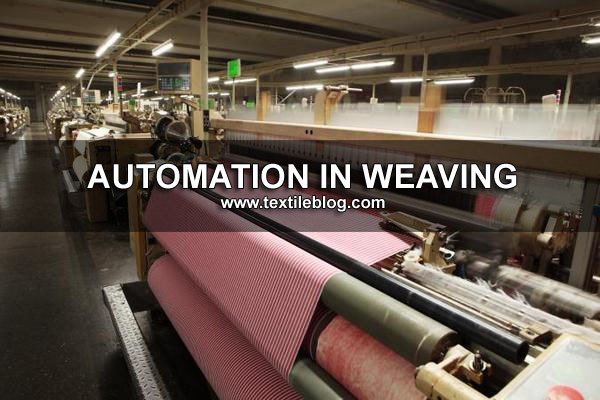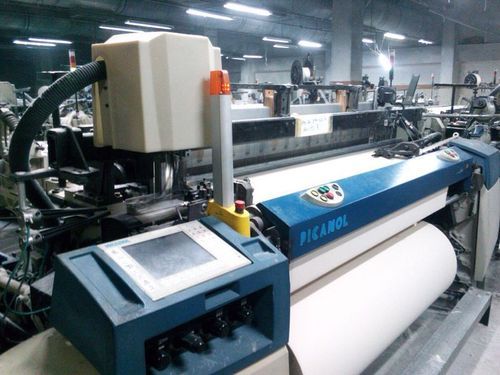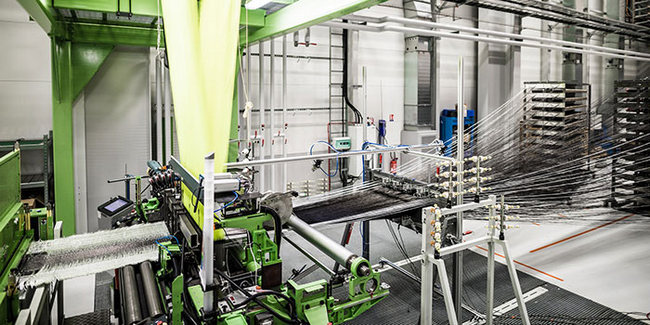Weaving is the most popular and widely used process of fabric production for the clothing, home furnishing and decoration. In fact, the word weaving means the process of fabric manufacturing, i.e. the process by which the fabric is made by interlacing of warp & weft threads is called weaving. Weaving machine have been using computer controlling device for a long time. Automation is used in weaving industry specially in winding, warping, sizing also used in loom. Some processes have been completely automated. The biggest benefit of automation in weaving machineries is that is saves labor, however, it is also used to save energy and materials and also to improve quality & accuracy.

Automation in Weaving:
The six different production steps such as Winding, Warping, Sizing, Weaving, Inspection and Packing. Basically, this sector has the most applications of automation in material handling & transporting. Only few applications deal with automating the machine operations themselves. Such as-
- Automatic Pick Repair
- Automated Warp Breakage Locator
- Computerized Machine Control
- Implementation of Electronic Control
- Computer Control in Automatic Looms
Why is automation important in the weaving industry?
Only qualified and appropriate technology ensures survival in global competition. In order to keep pace with the world, today’s weaving industry needs to ensure that it is able to produce and supply the best quality fabric in a very short time, at low cost. Automation/Robotics is the only options that can help the weaving sector achieve this goal. Let’s know the details about this-
Automation in Winding:
The use of automation in the winding process has increased its efficiency, making it possible to do much more windings than conventional methods. At the same time labor costs have come down. Here are some applications of automation in winding process:
- Drum Traverse System
- Individual Touch Panel Control System
- Automatic Bobbin Magazine Device
- Auto-Doffing and Control System
- Electronic Magnetic Tension Device
- Auto Circulating Lube System and Tank
Automation in Warping:
With the help of high-speed warping, the threads are wrapped in the warp beam very fast, if there are any defects in the threads, they are detected very quickly with the help of laser/photo optical sensor. The use of automation in the warping process has added some special features to the machine, such as-
- Auto stop motion sensor: As a result of using this sensor, if any thread is suddenly torn, it will stop immediately.
- The tension of each warp thread is equal/constant.
- Creel movement occurs automatically.
- The head stocks are equipped with advanced design features like proper direct drive, advanced electronics, smooth doffing and programmable braking.
- Automatic warp beam loading, doffing and chucking.
- Warp tension regulation for uniform build-up.
You may also like: Warping Process in Weaving: Objectives, Types, Operation and Problems
Automation in Sizing:
The sizing machines are very advanced, at present some tools are being used to control the sizing machine which ensures uniform sizing. This monitoring or controlling ability is being incorporated through a computer network in each weaving mill. Some examples are-
- The tension of the thread is going to be controlled by using sensors.
- The temperature and quantity of solution of size material is going to be controlled in sizing tank and sizing cooker.
- Helps to control the humidity by sensors including controlling the temperature in the drying zone.
- Headstock system is going to be controlled etc.
On Loom Automation:
The application of electronic controls, such as computer controls in automated looms, has made effective operations much easier than ever before, and quality fabrics are being produced. With the help of On-Line Monitoring System, the production monitor, breakage and stop monitor in each loom is able to improve the quality of the fabric. Also, the whole activity of weaving process is going to be completed at low production cost.

What Kinds of Automation are Possible in Loom?
1. Upgrading the old weaving machines/looms with following options:
Automation in Weaving Shed: Weaving technology is the most widely used method of fabric production for many sectors, including clothing and home furnishings. Technical textiles are also being produced with the help of modern weaving machines. However, new technologies have now been added to the shading mechanism in this weaving process. Mechatronic systems, a combination of mechanical CAM and SERVO drive for warp Let-off and fabric Take-up, are now one of the modern additions to the industry. Recently, Harness Motion and Weft Insertion have been combined with separate electric drives in some cases.
Electronic Let-off and Take-up mechanism: This type of let-off motion where the Weaver’s Beam is driven by a Servo Motor, as the diameter of the beam changes, the RPM of the beam is controlled by the Load Cell. Fabric on the other hand is synchronized with take-up, let-off speed. Due to the crimp in the warp, the speed of fabric take-up is less than the speed of the warp let-off.
Electronic Warp and Weft Stop Motion: The edge of each warp is monitored by a single drop wire. When a warp thread breaks or ruptures, the corresponding wire falls on the contact bar and the machine shuts down immediately. Like the warp, when the weft thread is sent, the machine will shut down if it is torn or broken.
Electromagnetic Warp Protector Motion: It is usually combined with high-speed shuttle loom and projectile loom.
2. Upgrading/Replacing the old card type design making with efficient computerized pattern making machines of Jacquard name salvage or full width Jacquard on existing looms.
Asia Automation Pvt. Ltd. offers a wide range of automation products for textile weaving looms and Jacquard. The products have been installed and exported to Indonesia for complete automation of air-jet weaving machines.
Air-jet Weaving Machine Controller: It is a high-speed machine micro-processor based controller for the total weaving machine control. It synchronises the weaving functions of the machine, controls the Let-off, maintain the warp tension.
Name Salvage for Jacquard: The computerized Pattern Making (CPM) controller comes in mainly two configurations 72 hooks and 144 hooks. The design software provides the tools for creating the design file. The file can be transferred directly or through memory cassette to the controller.
Full Jacquard-computerized pattern maker machines from 24 to 600 hooks: It’s a very high-end controller with touch screen for user interface. The computerized control offers high reliability due to minimum mechanical components and design flexibility at par with international standards.

Advantages of Automation in Weaving Sector:
The use of automation has made it possible to weave the fabric perfectly. The use of automation has made it possible to produce better and quality fancy fabrics. More fabric is going to be produced at the same cost and in less time. The working conditions of the operatives have been improved. Complex parts of Weaving’s entire activity are now being completed very easily and without risk. As a result of automation, weaving machines have come under electronic control, such as complex and different designs of jacquard fabrics can be made at the speed of production of ordinary fabrics. The speed of the machine has increased up to 1000 rpm, which means that the speed of the current machine is 5 to 10 times faster than 20 years ago.
Conclusion:
In some countries like Pakistan and Bangladesh, child labor in carpet weaving is still a big problem, unfortunately it remains an automation challenge as consumers prefer traditional looms to electric looms. Entrepreneurs in a decentralized market must be aware that reliance on automated weaving will greatly reduce overall costs and fabric defects. The story of automation in weaving is not the same in al developing countries, as countries like China are not only increasingly using automatic weaving machines but also exporting weaving machines to other countries. The global demand for Textile is increasing, so there is no other way to keep the wheel of our economy moving and to maintain the good position in the world market except the applications of automation in the weaving sector.
References:
- https://textilelearner.net
- slideshare.net
- Indiantextilejournal.com
- Fiber2fashion.com
- Asiaautomation.com
Author of this Article:
Md. Imran Hossain
B.Sc. in Textile Engineering
Shahid Abdur Rab Serniabat Textile Engineering College, Barisal.
Email: mdimranhossain.te@gmail.com
Articles published by same author:
- Automation in Textile Industry: Impacts, Advantages and Disadvantages
- Applications and Impacts of Automation in Fiber and Yarn Manufacturing
